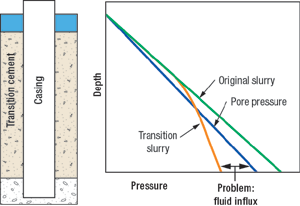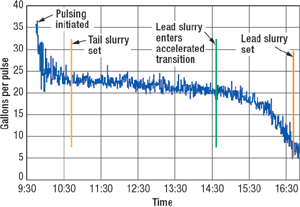|
|
|

By Petroleum Technology Transfer Council |
Pulsation prevents annular flow after cementing offshore
Cement pulsation technology, recently adapted offshore, has shown very encouraging results. After figuring in the cost, an operator realized savings of about $130,000 from eliminating potential Gulf of Mexico remedial cementing.
John Aslakson, W&T Offshore, Inc., Metairie, Louisiana, and Ed Smalley, CTES, L.P., Conroe, Texas
Annular flow after cementing conductor/ surface casing strings offshore, in the Gulf of Mexico (GOM), has plagued operators for years. Cost-effective mitigation remains a significant, ongoing problem. Minerals Management Services Safety Alert No. 216, issued in October 2003, noted that “annular flow related to cementing surface casing has been identified as one of the most frequent causes of loss of control incidents in the (GOM).”
At best, annular flow after cementing can generate significant, additional, wellbore construction costs related to remedial cementing operations. In more extreme cases, such flow can cause broaching, cratering and fire, which can be very costly.
SLURRY TRANSITION/ ANNULAR FLOW POTENTIAL
Annular flow after cementing is thought to result from cement column hydrostatic pressure loss that occurs during the slurry transition period. Transition period refers to when the cement column makes the transition from liquid to a solid, and no longer transmits full hydrostatic pressure. This occurs when cement starts to gel and can result in an underbalanced condition downhole.
Soon after the slurry is placed, the cement begins to support itself through its bond to the casing and formation. When this occurs (initial gel strength development), the column transmits a reduced hydrostatic pressure. Since this effect is cumulative over the cement column’s length, deeper sections of the wellbore may experience an underbalanced condition, allowing fluid influx into the unset slurry. This can create channels in the cement column, and flow/ pressure may be observed on the annulus, Fig. 1.
 |
Fig. 1. Hydrostatic head reduction during the slurry transition period.
|
|
TECHNOLOGY DESCRIPTION
Cement pulsation is a patented process that is relatively simple and inexpensive to apply. It maintains the cement column’s original hydrostatic pressure during the slurry transition period, until the cement develops sufficient strength to resist fluid influx. Cement pulsation utilizes low-frequency, small-amplitude water pulses applied to the annulus immediately after cement placement. These pulses shear the initial gel strength of the column’s unset portion, so hydrostatic pressure is maintained along the column length, and fluid influx is prevented.
Proprietary software is used to determine correct magnitude of the applied surface pulse. Pre-job pulse design helps ensure that pulse energy is sufficient to shear the gel strength of the entire cement column. When pulsing in shallow openhole intervals (< 2,000 ft), the software also makes certain that the equivalent circulating density (ECD) increase associated with the pulse is acceptable. The pulsation duration can be predicted with a standard, static, gel strength transition time test. Most cement slurries require 4 to 6 hr of pulsation.
Cement pulsation has been applied successfully to more than 600 onshore wells in the US and Canada. Onshore, the focus has been on improving zonal isolation (by preventing fluid migration after cementing) on production casing strings. Pulsation has been applied in well depths from 1,800 to more than 12,000 ft. In spite of being applied in fields where remedial cementing was required on more than 30% of the wells, the overall cement pulsation success rate (defined as achieving zonal isolation/ no annular pressure after cementing) has been about 95% on all wells deviated less than 30°.
FIELD LOCATION
W&T Offshore conducted a drilling program on Outer Continental Shelf/ South Timbalier Block 229, about 40 mi off the Louisiana coast in about 235 ft of water. This site was selected for cement pulsation, because offset wells had experienced annular flow and/or pressure within 18 hr after cementing the conductor or surface casing. When this occurs, the operator incurs remedial annular cement squeeze operations potentially costing $150,000 (rig time and associated costs). In contrast, the conductor or surface casing for a typical offshore Louisiana well can be pulsed for roughly $15,000, including mobilization and up to three days of standby time.
WELLBORE CONFIGURATION/ CEMENT SLURRY DESIGN
Drive pipe was set to 750 ft, and the wellbore was drilled to 1,550 ft with a 17-1/2-in. bit size. It was then underreamed to 24 in., and 18-5/8-in. conductor pipe was set to TD. The conductor pipe slurry design placed several materials during the cementing operation, Table 1.
| |
TABLE 1. Material placement during cementing |
|
| |
Material |
Bottom
depth, ft |
Top
depth, ft |
Density,
ppg |
|
| |
|
|
| |
Seawater |
31 |
0 |
8.4 |
|
| |
Spacer |
368 |
31 |
9.8 |
|
| |
Lead slurry |
1,250 |
368 |
12.0 |
|
| |
Tail slurry |
1,550 |
1,250 |
16.4 |
|
|
The lead cement slurry design was developed to control potential flow after cementing. It was specified with a fluid loss of 26 cc/30 min., and zero free water at a 45° angle. Laboratory pump times for lead and tail slurry were 6:00+ and 2:42 hr., respectively.
PULSE MAGNITUDE DESIGN
The applied surface pulse pressures used on these shallow GOM casing strings were reduced well below typical values of about 100 to 140 psi that have been utilized when pulsing deeper production casing strings on land. This change was made to remain below the crucial fracturing pressure of shallow sands being cemented in the openhole interval. These sands had a narrow gradient between pore and fracture pressures. Particular attention was focused on the ECD increase that occurs when very shallow formations are pulsed.
The cement pulsation job design software determined an appropriate surface pulse pressure. The software utilizes cement slurry design parameters and mechanical properties of the openhole interval to predict amplitude of the downhole pressure pulse vs. depth, including the impact of pulse attenuation versus depth. A surface-applied pulse pressure of about 60 psi was used. This was sufficient to shear the entire cement column to TD, but small enough to remain below the critical fracturing pressure of the weakest openhole zone. Pulse frequency was roughly 40 sec.
SURFACE INDICATION OF DOWNHOLE CEMENT SETTING
The volume of water used to apply each pressure pulse on the annulus is recorded by cement pulsation equipment and defined as compressible volume. The cement column’s compressible volume is largest as the pulsation operation begins, because the entire column is in a fluid state and provides for a small amount of compressibility. Compressible volume will normally decrease over time, as the column develops sufficient gel strength to preclude cement pulsation shearing action at the cement-to-formation/ casing interfaces. This decrease in compressible volume during pulsing can directly indicate progress of the downhole cement setting process.
This well’s initial compressible volume measurement was just in excess of 30 gal/pulse. After one hour of pulsing, the compressible volume decreased to about 23 gal/pulse, Fig. 2. The compressible volume remained nearly constant over the next 4 hr, measuring 21 gal/pulse at hour five. At this point, the compressible volume measurement began to decline much faster. Compressible volume had declined to 6 gal/pulse by hour seven, where it stabilized, and the pulsation treatment was deemed complete.
 |
Fig. 2. Compressible volume at surface indicates when cement is set.
|
|
These changes in compressible volume measurement versus time provide a surface indication of downhole setting events. The 7-gal decrease observed after hour one indicates a lead cement slurry setting event. At this point, pulse pressure no longer contains sufficient energy to shear the lead slurry’s gel strength. The period between one and five hours, where there is little change in compressible volume, corresponds with the longer set time associated with the lead slurry. The lead slurry appears to complete its transition period between hours five and seven of the pulsing operation, at which time gel strength could no longer be sheared by the pulsing.
FIELD RESULTS
Combining cement pulsation with a sound cement program design and proper cementing practices yielded the desired results – a high-quality cement job with no annular pressure or flow afterwards. A costly annular squeeze job and/or loss-of-well control incident was potentially avoided. W&T Offshore has utilized cement pulsation with conductor and surface casing cementing on additional wells. Results are encouraging. 
ACKNOWLEDGMENT
The technical details contained in this case history were reported in SPE paper 94230, Aslakson, J., D. Doherty and E. Smalley, “Preventing annular flow after cementing, one pulse at a time: Offshore Gulf of Mexico cement pulsation field results,” 2005 SPE Production and Operations Symposium, Oklahoma City, Oklahoma, April 2005.
THE AUTHORS
|
| |
John Aslakson is a drilling engineer with W&T Offshore, Inc., with Gulf of Mexico (GOM) responsibilities. His drilling career has been US-focused, covering Wyoming, Utah, Alaska, Louisiana and the GOM, working with a major, service provider and research organization. He holds a BS degree in mechanical engineering from Montana State University and an MS degree in engineering administration from the University of Utah. He is a member of SPE and AADE. Email: jaslakson@wtoffshore.net
|
|
| |
Ed Smalley serves as VP of Business Development for CTES, L.P. in Conroe, Texas, where he is responsible for commercializing new products. Previously, he spent 11 years with Gas Technology Institute, with a focus on commercializing new E&P technology. He began his career with Schlumberger, where he held various positions in sales and operations. Mr. Smalley holds a BS degree in engineering from Kansas State University, and is a member of SPE, ICoTA and SPWLA. Email: ed.smalley@ctes.com
|
| |
|
|




